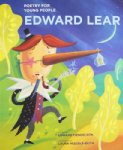Through the Looking Glass Children's Book Reviews
Poetry for Young People: Edward Lear
Illustrator: Laura Huliska-Beith
Poetry Picture Book
For ages 8 and up
Sterling, 2010 ISBN: 978-1402772948
Most people have, at some point of another, encountered Edward Lear’s wonderful poems and limericks. So many of his poems are memorable because they are delightfully peculiar and often funny. The strange thing is that Edward Lear was a sad person much of the time. He was only really happy when he was creating art or writing. Though he did make friends, he never married and was often lonely. As so often is the case with lonely people, Lear was very fond of children and animals. He enjoyed creating stories and pictures about animals that children found entertaining. His first collection of poetry, A Book of Nonsense, contained artwork and poems that he had written for some children whom he befriended.
In this excellent poetry picture book readers will encounter a wide variety of poems that Edward Lear wrote. Some will be familiar like The Owl and the Pussycat, The Jumblies and Calico Pie, while others will be new to the reader. What makes this collection special is that the editor provides readers with an introduction about Lear’s life and work at the beginning of the book, and every poem is prefaced by a note that gives readers further information about that poem. Thus every poem is given a context that helps us to better understand what Edward Lear was trying to achieve when he wrote the piece.
Though many of the poems are nonsensical, they do have underlying themes that are serious in nature. The famous poem, The Owl and the Pussycat is about an owl and a cat who, despite their differences, want to be a couple, so they “sailed away, for a year and a day,” to an island where they were married and the poem ends on such a happy note that we are sure that they will find happiness.
In The Scroobious Pip, we meet a creature that is not a mammal, a bird, a fish, or any other kind of recognizable animal. The other animals are troubled by this and they appoint some of their number to ask the Scroobious Pip “Are you Beast, or Insect, Bird or Fish?” Some creatures would develop a complex being asked this question so many times, but the Scroobius Pip does not allow himself to be perturbed. He is content being who and what he is.
Throughout the book the editor also provides us with definitions of some of the words used in the poems. This feature will certainly help readers to appreciate the poems fully. After all, many of us have no idea what a “snuffer” or “Stilton Cheese” is.




